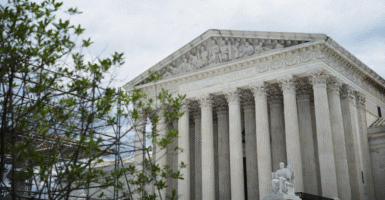The Presidential Commission on the Supreme Court met Tuesday for its second public meeting, hearing from 27 witnesses about everything from the court’s so-called shadow docket to court-packing and time limits for the confirmation process.
The commission’s report for President Joe Biden is due by mid-November, but if this and its May 19 meeting are any indication, this exercise may be, to quote Shakespeare, a lot of “sound and fury signifying nothing.”
A Heritage Foundation legal memorandum published in June documented how commissions on court reform and other subjects are created to examine an identified problem or issue and offer recommendations to solve or address it. This commission is different.
When Biden created the commission in April, he did not identify a problem that needed reform and did not instruct the commission to make any recommendations.
Instead, Biden created this commission to appease left-wing activists demanding that the Supreme Court actually be expanded and then packed with justices likely to rule the way they want on key issues.
Biden opposed this idea when he was a senator and during most of the presidential campaign. Days before the 2020 election, he said in a “60 Minutes” interview that he would appoint a commission that would “not [be] about court-packing” but “a number of other things.”
As expected, however, court-packing was one of the most prominent issues during the commission’s July 20 meeting. John Malcolm, director of the Meese Center for Legal and Judicial Studies at The Heritage Foundation, testified on a panel with two aggressive court-packing advocates. (The Daily Signal is the news and commentary platform of The Heritage Foundation.)
Chris Kang, chief counsel of the progressive group Demand Justice, argued that the Supreme Court should be expanded to “balance” the current 6-3 majority of Republican appointees. Malcolm responded that the court has had even larger majorities appointed by one party without the other calling for court-packing.
Another witness on that panel, Alliance for Justice President Nan Aron, observed that a majority of current Supreme Court justices were appointed by Republican presidents (George W. Bush and Donald Trump) who were elected with less than a majority of the popular vote. She implied that this makes those justices, and even the court itself, less legitimate.
Malcolm responded to this as well, observing that President Bill Clinton was also elected, not once but twice, with less than a majority of the popular vote. (In fact, Clinton’s 43% in the 1992 election was lower than either Bush in 2001 or Trump in 2016). That did not, Malcolm said, in any way undermine the legitimacy of Clinton’s two Supreme Court appointees, Justices Ruth Bader Ginsburg and Stephen Breyer
In his prepared statement, Wade Henderson, interim president of the Leadership Conference on Civil and Human Rights, said the Supreme Court should “represent and reflect the vast diversity of our country” and that justices should “possess diverse backgrounds that will inform their role on the bench.”
He listed no less than 10 different categories of diversity, from race and sexual orientation to socioeconomic status and “experiential” background, but did not explain how any group of nine people could possibly reflect an entire nation in even the most general way.
For Henderson and other liberals, however, diversity is really just a means to an end. They believe that judges with a certain “diversity” profile will be more likely to make politically favorable decisions.
At one point, Henderson actually said that he wanted judges who possess “a progressive vision of the law and Constitution” when they decide cases involving “voting rights … reproductive health, educational equity … environmental protections, and more.”
If liberals really favored diversity, they would not have consistently opposed Trump’s minority and female judicial nominees. He appointed half of all Asian Americans who have served on the U.S. Court of Appeals in the last 50 years. They include the first Asian American judges on the 5th and the 6th Circuits.
Of these Asian American judges, Trump’s appointees received a combined 304 votes against their confirmation, compared to a total of just four negative votes for the judges appointed by other presidents. The women Trump appointed to the U.S. Court of Appeals received three times as many negative votes as those chosen by President Barack Obama.
The number of Supreme Court justices, the length of their terms, and their personal characteristics, however, are all secondary issues. The real issue, which America’s Founders debated when drafting the Constitution, is the kind of judge someone will be. The Founders designed a system in which the Constitution controls judges; contemporary “reform” advocates want a very different system in which judges control the Constitution.
When he dissented in the same-sex marriage case of Obergefell v. Hodges, the late Justice Antonin Scalia wrote that it is
of overwhelming importance… who it is that rules me. Today’s decree says that my Ruler, and the Ruler of 320 million Americans coast-to-coast, is a majority of the nine lawyers on the Supreme Court … This practice of constitutional revision by an unelected committee of nine, always accompanied (as it is today) by extravagant praise of liberty, robs the People of the most important liberty they asserted in the Declaration of Independence and won in the Revolution of 1776: the freedom to govern themselves.
If the Supreme Court needs “reform,” it is a renewed commitment to appointing justices who will impartially interpret and apply the law, fulfilling the limited role the Founders designed for the judiciary.
Have an opinion about this article? To sound off, please email [email protected] and we’ll consider publishing your edited remarks in our regular “We Hear You” feature. Remember to include the URL or headline of the article plus your name and town and/or state.
































